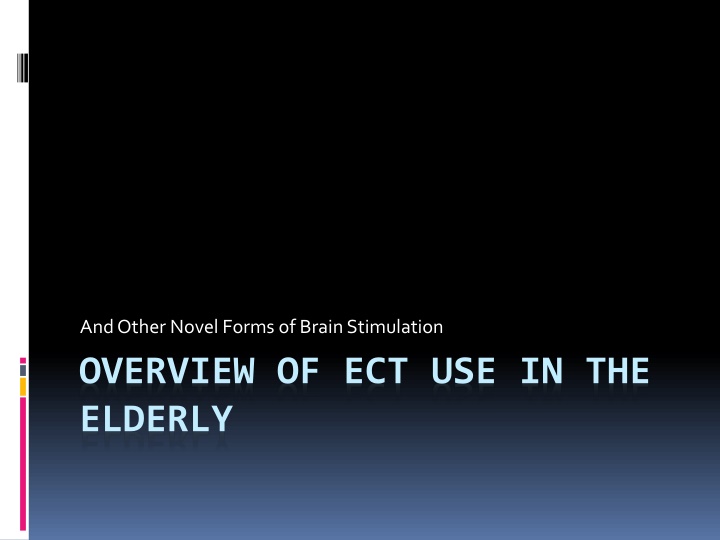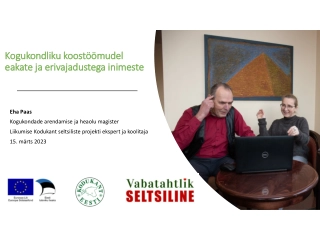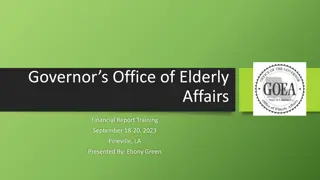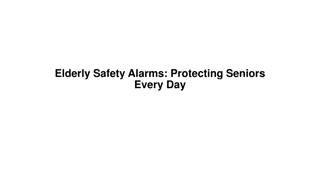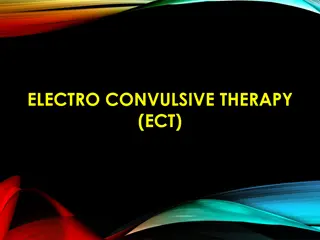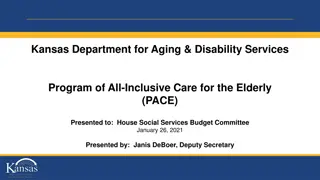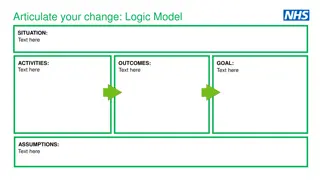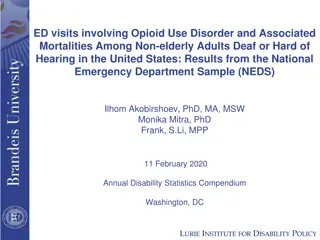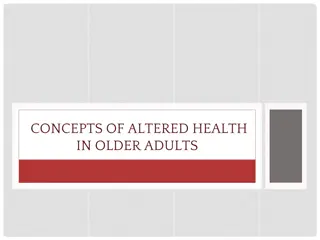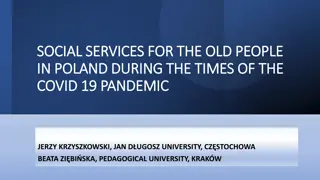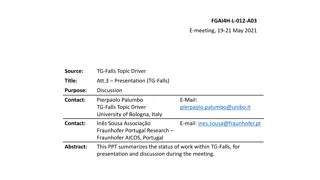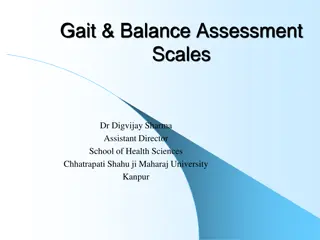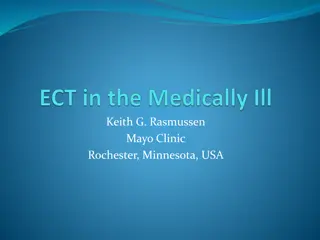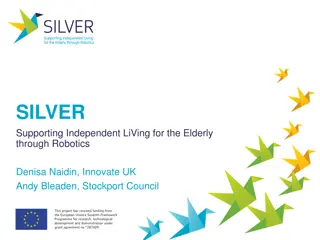OVERVIEW OF ECT USE IN THE ELDERLY
This overview delves into the strategic indications, primary and secondary indications, principal diagnostic indications, and other diagnostic indications of Electroconvulsive Therapy (ECT) in the elderly population. It covers a range of psychiatric conditions such as major depression, mania, schizophrenia, and refractory OCD, discussing when ECT can be considered as a treatment option.
Download Presentation

Please find below an Image/Link to download the presentation.
The content on the website is provided AS IS for your information and personal use only. It may not be sold, licensed, or shared on other websites without obtaining consent from the author.If you encounter any issues during the download, it is possible that the publisher has removed the file from their server.
You are allowed to download the files provided on this website for personal or commercial use, subject to the condition that they are used lawfully. All files are the property of their respective owners.
The content on the website is provided AS IS for your information and personal use only. It may not be sold, licensed, or shared on other websites without obtaining consent from the author.
E N D
Presentation Transcript
And Other Novel Forms of Brain Stimulation OVERVIEW OF ECT USE IN THE ELDERLY
Robert M Greenberg, M.D. Chief, Geriatrics, Geropsychiatry and ECT - Lutheran Medical Center (Brooklyn, N.Y.) Co-Chair, AAGP Clinical Practice Committee Disclosures: NIMH funding for C.O.R.E./PRIDE Study (Prolonging Remission in Depressed Elderly)
ECT - STRATEGIC INDICATIONS Nota treatment of last resort Should be considered along a continuum of options Primaryvs.secondary indications
ECT PRIMARY INDICATIONS Severityof psychiatric/medical condition requires rapid/definitive response Risks of other treatments outweigh ECT risks Prior hx of poor medication response or good ECT response Patient preference
ECT SECONDARY INDICATIONS Medication resistance Failure to respond to one or more adequate medication trials Must consider issues of medication choice, dose, duration, compliance Medication intolerance/adverse effects Deteriorationof psychiatric/medical status
ECT PRINCIPAL DIAGNOSTIC INDICATIONS Major depression(best evidence base) Unipolar or bipolar Response rates - ~60%(med-resistant) - ~90% Highest for psychotic depression (up to 95%) Mania Includes mixed states and rapid cycling Schizophrenia Recent onset or acute exacerbation Catatonic type Other psychotic disorders Catatonia , schizoaffective, psychosis nos Effective for acute episode and relapse prevention
ECT OTHER DIAGNOSTIC INDICATIONS Other psychiatric disorders Refractory OCD (with or without depression) Chronic pain syndromes (with associated mood disorder) Efficacy unclear, use rare
ECT OTHER DIAGNOSTIC INDICATIONS (CONT.) Mental Disorders due to Medical Condition Delirium various causes (use very rare) Catatonia secondary to various medical conditions Mood and psychotic disorders secondary to medical conditions SLE, Cushing s, etc. Post-stroke depression Depression secondary to Parkinson s, Alzheimer s, Huntington s, or other neurodegenerative disorders
ECT OTHER DIAGNOSTIC INDICATIONS (CONT.) Medical disorders Parkinson s disease Benefits motor symptoms independent of depression Particular benefit with on-off phenomenon Durations of benefit highly variable Continuation/maintenance ECT may be useful Neurolepticmalignant syndrome (NMS) Caution with autonomic instability Intractable seizure disorder
ECT - CONTRAINDICATIONS No absolute contraindications- only relative (except possibly for cochlear implants) Risk/benefit analysis required Severity/duration of psychiatric illness, and its threat to life Likelihood of benefit with ECT Medical risks of ECT and their modifiability Risks/benefits of alternative TX or no TX
ECT HIGH RISK Increased intracranial pressure Unstable/severe cardiovascular disorders Recent M.I., unstable angina, poorly compensated CHF, severe valvular disease (critical aortic stenosis), serious untreated arrhythmias Unstable aneurysm/vascular malformation Recent stroke/CNS bleed Severe pulmonary disorders (COPD, asthma, pneumonia) ASA level 4 or 5
PRE-ECT EVALUATION Psychiatric history and exam Include prior TX and response, prior ECT Medical history and exam, including teeth Goal optimize medical status & management Concept of clearance not useful Laboratory tests Goal confirm presence/severity medical risks None routinely required Anesthetic evaluation ASA class, need to modify technique or meds
PRE-ECT EVALUATION (CONT) Typical labs CBC, Lytes, ECG, (CXR) Others as clinically indicated Spine films with severe osteoporosis/sx s Neuroimaging, EEG if pathology suspected Blood level monitoring for warfarin, digoxin, antiarrhythmic, anticonvulsants Echocardiogram, Holter, stress test if indicated Repeat pre-anesthesia physical every 6 mos Repeat consent post 12-25 TX in series, when starting CECT, and at least every 6 mos for MECT Repeat labs at least yearly (more if needed)
CRITERIA FOR AMBULATORY ECT Psychiatric status Not acutely psychotic/suicidal Behavior/compliance predictable Medical status Relatively stable; ASA class 1 or 2 (?3) Social factors Responsible caretaker to: Monitor compliance, report progress,adverseevents Provide transport & supervision after ECT
Number of ECT Should be function of response and adverse cognitive effects Wide individual variation Generally continue until remission or plateau in improvement Monitor target symptoms between each treatment Typical course for mood disorders 6-12 ECT Some patients remit with fewer than 6 Some patients require more than 12 Greater numbers often needed for schizophrenia Avoid pre-determined treatment numbers
Number of ECT Consider ECT modification if no significant response by ~6 treatments: Dose increase Switching from unilateral to bilateral Medication inhibiting or augmenting Policy needed regarding maximum number ECT in acute treatment series prior to formal re-assessment and re-consent Typically 12-25 Consider consultation Repeated ECT courses sometimes needed No evidence for lifetime maximum
Frequency of ECT U.S. - 3x weekly standard Britain/Europe -2x weekly common May start daily ECT for severe illness/rapid response urgent Decrease frequency with severe cognitive dysfunction/delirium
Frequency of ECT Conclusions 3x weekly ECT Rapid response urgent, hospitalized patients 2x weekly ECT Minimizing cognitive effects a priority (e.g., outpatients) May vary interval during course of ECT Decision about treatment frequency made in conjunction with electrode placement 3x weekly RUL ECT rarely problematic
STIMULUS DOSING/ELECTRODE PLACEMENT-General Principles Seizure thresholds may vary widely (40X), but most fall within narrower range Higher with >age, males, BL (vs. RUL) ECT Known variables predict <40% of variance Threshold may rise 25-200% over ECT course Stimulus dose relative to threshold affects: Efficacy (with RUL ECT) Rate of response (RUL and BL ECT) Cognitive side effects
STIMULUS DOSING AND ELECTRODE PLACEMENT Three methods for choosing stimulus dose: 1. Fixed dose Not recommended (except high-risk patients) 2. Formula-based dosing Limited accuracy 3. Empirical titration Most accurate
ELECTRODE PLACEMENT/ STIMULUS DOSE (cont) Stimulus Dose Determination BL Titration or Age (Petrides 1996) Seizure thresholds can vary 40-fold (Sackeim 1991, 1993) BUT Most fall within smaller range 96% 50-200mC, 80% 100-200mC (CORE-JECT 2009) RUL Titration more important Dose-response relation can effect outcome Fixed high-dose an option, but will result in excessive dosing for some (McCall 2000)
STIMULUS DOSING AND ELECTRODE PLACEMENT RUL ECT Efficacy =BL ECT when dosed 6X threshold Significant cognitive advantages at 1 wk & 2 mos, c/w 2.5X threshold BL ECT Efficacy more modest at lower doses: 30-44% response at 1.5 2.5X threshold 17% response just above threshold Positive dose-response relationship found at least to 12X threshold Slope of cognitive deficits steep at 8-12X threshold
STIMULUS DOSING AND ELECTRODE PLACEMENT BL ECT Effective even close to threshold Rate of response andcognitive side effects increase with dose (relative to threshold) Optimum dose ~ 1.5 2.5X threshold Refs: Sackeim et.al. Arch Gen Psych May 2000; NEJM 1993. McCall et.al. Arch Gen Psych May 2000
ELECTRODE PLACEMENT/ STIMULUS DOSE Choice is Good Bilateral Still the gold standard 1stchoice when rapid, definitive response urgent Dose 1.5 2.5 x threshold Cognitive effects at 1.5x threshold = RUL at 8x threshold (McCall JECT 2002) Fastest response Bifrontal Conflicting data (Lawson, Letemendia, Bailine, etc.) Response rates intermediate RUL BL (non-signif.) No clear cognitive advantage (CORE Br Jnl Psych 2010)
ELECTRODE PLACEMENT/ STIMULUS DOSE (cont) Right Unilateral Best choice in non-urgent situations, when minimizing memory effects important Positive dose response curve (McCall 2000) Efficacy approaches BL at 6x threshold (Sackeim 2000). Less data in non-affective disorders
OPTIMIZING ECT STIMULUS Brief pulse bidirectional square wave Stimulus dose depends on: Pulse frequency, width, train duration, amps Stimulus charge (mC) = IxT Longer duration, shorter pulse width best Ultra-brief pulse(<= 0.3 msec) most efficient, least cognitive side effects May be less effective with BL ECT (unclear) Relative efficacy/efficiency needs further study, but initial good outcome data in elderly (CORE/PRIDE 2013 ISEN poster submission)
MEDICAL SEQUELAE OF ECT Cerebral Increased blood flow, metabolic rate Increased blood-brain barrier permeability Cardiovascular Initial increased vagal tone Sinus pause, bradyarrhythmias, escape arrhythmias Subsequent increased sympathetic tone Hypertension, tachycardia, PVC s/tachyarrhythmias Risk of ischemia, CHF, arrhythmia
ECT MEDICAL SIDE EFFECTS (CONT) Prolonged apnea Maintain adequate oxygenation Check dibucaine number/pseudocholinesterase Post-ictal delirium Supportive environment I.V. lorazepam,haloperidol,methohexital, etc. Orthopedic complication rare Risk > with osteoporosis; consider > succinylcholine Severe cardiovascular/pulmonary complication very rare Death extremely rare (<1/10,000)
ECT COGNITIVE SIDE EFFECTS Effects largely limited to explicit memory Anterograde and retrograde Characteristic pattern acute, sub-acute, longer term Extent and severity of memory effects vary widely Influenced by patient and treatment variables
ECT COGNITIVE SIDE EFFECTS (CONT) Noevidence of brain damage Noimpairment of other cognitive functions: Executive functions, reasoning, creativity, I.Q., semantic memory(knowledge), procedural memory(skills), personality Global cognitive status and I.Q. typically improvesoon after ECT course Related to improved attention/concentration
ECT MEMORY EFFECTS Acute Transient confusion/disorientation Resolves in minutes to few hours Sub-acute Anterograde trouble learning/retaining new information; resolves in days to weeks(months) Retrograde trouble remembering events up to several months (rarely years) before ECT Many memories return within weeks to months Temporal gradient events closest to ECT most likely to be forgotten
ECT MEMORY EFFECTS(CONT) Longer term effects Involves retrogradememory only Variable gaps may persist over variable time Amnesia greater for public than personal events Older memories more likely to return Events close to ECT course may not be recalled Rarely, troubling amnesticgaps extending back several years may persist
COGNITIVE SIDE EFFECTS PATIENT VARIABLES Preexisting cognitive impairment Low MMSE, Alzheimer s, Parkinson s, stroke Greater risk persistent retrograde amnesia Duration of post ECT confusion Predicts severity of retrograde amnesia MRI findings of BG lesions, WMHI s Predicts ECT induced delirium
COGNITIVE SIDE EFFECTS TREATMENT VARIABLES Stimulus waveform Sine wave>brief pulse >ultra-brief pulse Electrode placement Bilateral>right unilateral ? Bifrontal, LART more research needed Stimulus dosing Greater if markedly suprathreshold, especially bilateral Treatment interval 3x per week > 2x per week Medications Lithium, anticholinergics, high dose anesthetic
PREDICTORS OF ECT RESPONSE Clinical Shorter episode duration Less medication resistance Psychotic subtype Catatonia Older age ?Absence of severe anxiety, personality disorder
Effect of Age on Remission Rates with ECT Remission rates* of patients (n=253) after acute phase, bilateral ECT 100 100 86.4 86.4 90 90 80.0 80.0 80 80 70 70 Rate (%) 57.0 57.0 60 60 50 50 40 40 30 30 20 20 10 10 0 0 65 45 46-64 Age (years) O Connor et al. Am J Geriatr Psychiatry 2001
Effect of Psychosis on ECT Response (Petrides et al JECT 2001) Population 253 patients with unipolar MDD 177 non-psychotic , 76 psychotic ECT BL, 50% above threshold Overall remission rate: 87% Psychotic - 95% Non-psychotic 83%
Effect of Psychosis on ECT Response (Petrides et al JECT 2001)
RELAPSE FOLLOWING ECT Major clinical problem (major depression) Overall, > 50% relapse within first 6 mos. Relapse often rapid 80% of 1st year relapsers do so in 1st 4 mos. Relapse rate especially steep in 1st mos. Early data on antidepressant prophylaxis did not consider medication resistance pre-ECT
Predictors of relapse Medication resistance1 Psychosis2 Not achieving remission during index course 3 No good data on the elderly 1. Sackeim et al., 1990 ;2. Aronson, Shukla, & Hoff, 1987; Spiker, Stein, & Rich, 1985; 3 (Prudic, Olfson, Marcus, Fuller, & Sackeim, 2004)
RELAPSE FOLLOWING ECT Effect of Medication Resistance (Sackeim et al. J Clin Psychopharmacol 1990) Overall, med-resistant group (failed TCA) relapsed at twice the rate of non-resistant group (64% vs. 32%) In med-resistant group,adequate post-ECT pharmacotherapy had little impact on relapse (53% vs. 65%) In non-resistant group,adequate post-ECT pharmacotherapy substantially reduced relapse (8% vs. 50%)
Medication Resistance Predicts Relapse Following Successful ECT 1 Significantly greater relapse in patients with two or more medication failures (p=0.01) Cumulative Probability of 0.8 Not Resistant (36% relapse) Remaining Well 94% of relapses occurred in the first 6 months 0.6 0.4 Medication Resistant (68% relapse) 0.2 0 10 20 30 40 50 0 Weeks Sackeim HA, et al. Arch Gen Psychiatry. 2000;57:425-434.
Relapse Following ECT What works (cont d) Sackeim et al JAMA 2001 Patient Population 159 ECT remitters (/290) 84 patients entered continuation phase following remission with ECT Dx - unipolar major depression (severe - psychotic and non-psychotic) Previously rated for adequacy of pre-ECT medication trials
Relapse Following ECT What works? (continued) Study Design Double-blind, random assignment to: - NT + Placebo - NT + Li Co3 - Placebo + Placebo Followed for 6 months
Relapse Following ECT What works? (continued) Results Placebo NT NT + LiCo3 All pt s relapsing on NT + Li did so in 1st 5 weeks Other groups relapsed throughout entire 6 month period Follow-up study (OPT-ECT Arch Gen Psych 2009; JECT March 2013) Randomized to NT, VEN, or placebo during ECT, Li added after ECT No change in relapse rates (50% at 6 months), but NT (and VEN) improved acute ECT response by 15%; NT improved cognitive outcome. Less relapse with older age 84% relapsed 60% relapsed 39% relapsed
CONTINUATION THERAPY FOLLOWING ECT General Principles Patients receiving ECT often have recurrent and medication-resistant illnesses Need for aggressive continuation TX following ECT course is compelling Continuation TX may be meds and/or ECT Relapse often occurs quickly begin continuation TX ASAP Consider ECT taper for most patients
CONTINUATION PHARMACOTHERAPY Unipolar Major Depression Avoid agents ineffective pre-ECT In resistant pts, consider agents with mixed profiles or combination/augmentation strategy Limited data NT + Li, ?Venlafaxine + Li, etc. Continue antipsychotic in psychotic depression Use same doses as for acute treatment
CONTINUATION ECT Indications Illness responsive to ECT Patient preference for CECT or Resistance/intolerance to pharmacotherapy Ability & willingness of pt (or surrogate) to: Receive CECT Provide informed consent Comply with treatment plan and restrictions
CONTINUATION ECT Usefulness described in patients with: Major Depression Bipolar Disorder Schizophrenia Parkinson s Disease Most data from retrospective case series Prospective, multi-site study completed Comparison of CECT with NT + Li C.O.R.E. Study- MSSM, Duke, Wake-Forest, NY Presbyterian, MUSC, LIJ, U. of Texas, Mayo Clinic Results CECT = NT+Li in relapse prevention
C.O.R.E. CECT STUDY Multi-site, randomized, parallel design 201 pts, MDD, remitted with BL ECT 6 month trial C-ECT (10 TX) vs. C-PHARM (NT + LiC03) C-ECT 37.1% relapse, 16.8% drop-out C-PHARM 31.6% relapse, 22.1% drop-out Mean survival- 9.1 weeks C-ECT vs. 6.7 weeks C-PHARM Kellner et al Arch Gen Psychiatry 2006
